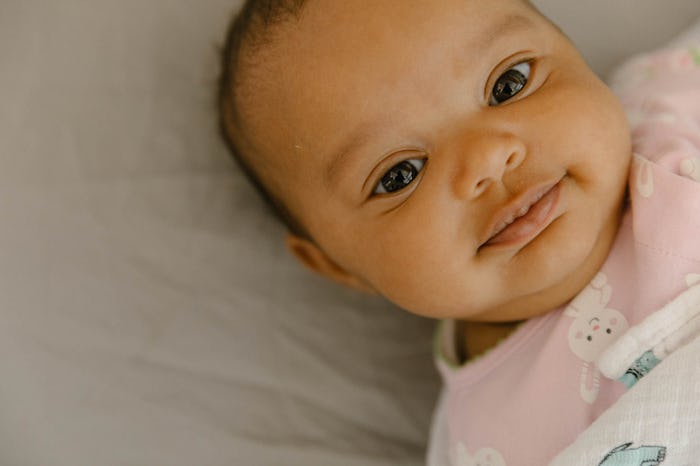Life
Newborns Are Prone To Breaking Their Collarbones, & Here's What You Need To Know
When I was 12, I called my mom to tell her I had been on my friend's tire swing when the rope snapped, my ankle crushed underneath it. At age 4, my sister fell down the steps, her bleeding head leading to an emergency room trip. By age 8, my risk-taking brother had broken seven bones. The point? Raising kids certainly comes with its share of scrapes and injuries. But it's not something you think about when they're infants, right? Turns out you might. After all, newborns are prone to breaking their collarbones, and here's what you need to know.
"All cases of newborn collar fracture have been a result of moving through the birth canal," Stacy M. Menz, a pediatric physical therapist and board certified pediatric clinical specialist at California-based Starfish Therapies, tells Romper in an email interview. "It generally happens when a baby is on the larger side." Menz says a newborn collar fracture can also be the result of arm placement as a baby passes through the birth canal.
If you're surprised to learn of this injury, then you might also be shocked to hear this: Collarbone, or clavicle, fractures are the most common injury sustained by newborns during birth, according to Nationwide Children's. In addition to being large in size, a baby may be at risk for a clavicle fracture if their shoulder gets stuck during delivery, if a mother has a narrow birth canal, or if tools are used to assist with the delivery, the website noted.
But how do you know if your little one has a fractured collarbone? Nationwide Children's also noted that the most common symptom associated with a fractured collarbone in a newborn is fussiness or crying when the affected arm is moved. Your baby may also experience pain when you lift them under the arms, and/or they may not move the affected arm as much as the uninjured arm, according to the website. Slumping or sagging of your child's shoulder down and forward might also be noticeable, according to Kids Health. Clavicle fractures usually heal without incident and no treatment is required, but an arm support like a sling or wrap might be used to ease pain and keep the bone in position as it heals, noted Kids Health.
Other common birth injuries include bruising or marks on the face or head as a result of passing though the birth canal or if forceps are used during delivery, according to Stanford Children's Health. Vacuum extraction may also leave some scalp bruising or a scalp laceration. On the other hand, subconjunctival hemorrhage — or the breakage of small blood vessels in the eyes of a baby — may also occur, the website noted. These injuries, however, do not cause permanent damage and usually disappear in a short period of time.
On the other side of the birth equation, of course, is the mother. In the event that a mother experiences a traumatic birth — whether it is the result of physical difficulties or emotional issues — the recovery can take time. Severe tears, assisted births, and/or feelings of being out of control during birth may all lead a mother to associate trauma with her birth, according to Baby Center. As noted in Psychology Today, unrealistic expectations of the birth experience are often at the heart of a traumatic birth. Rachel Yehuda, the director of the Traumatic Stress Studies Division at the Mount Sinai School of Medicine, perhaps summed it up best when she said: "The way that I like to define a trauma is a watershed event, an event that kind of divides your life into a before and after."
Which, interestingly enough, is kind of the definition of birth too. Because no matter how that little one arrives, it's hard to imagine life before they did.
Check out Romper's new video series, Bearing The Motherload, where disagreeing parents from different sides of an issue sit down with a mediator and talk about how to support (and not judge) each other’s parenting perspectives. New episodes air Mondays on Facebook.
